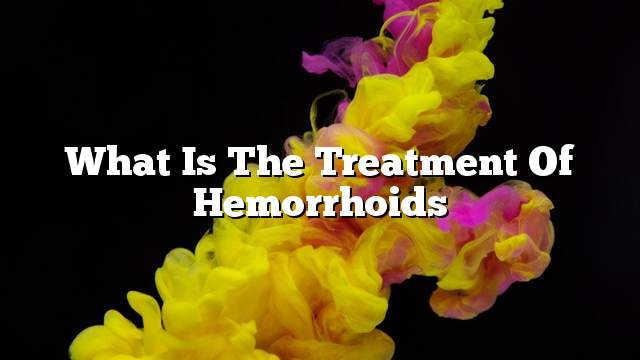Hemorrhoids
Hemorrhoids are common diseases, affecting 75% of adult men and women. Hemorrhoids can be defined as swollen and inflamed blood vessels in the anus and below the rectum. They are divided into two main types: internal hemorrhoids that do not cause pain and arise In the rectum, and external hemorrhoids that occur under the skin around the anus and cause itching and bleeding, it should be noted that the incidence of anal bleeding does not necessarily mean the presence of hemorrhoids, it may be indicative of the existence of other diseases such as colon cancer and anal cancer, especially if the patient has a change In the bowel movement and change in the color of the stool or its nature.
Treatment of hemorrhoids
Treatment of home hemorrhoids
The patient can treat hemorrhoids home-based if the accompanying pain is simple, and possible home remedies for pain relief and bloating include:
- Eating plenty of foods high in fiber, such as vegetables, fruits and whole grains, helps to facilitate the exit of waste from the anus without the need for pressure and tension during the output. It is worth mentioning that the need to increase the intake of fiber gradually because it causes increased gases.
- Use warm submersibles by sitting in the water for 10-15 minutes two to three times a day.
- Keep the anal area clean by bathing daily and gently cleaning the anal area with warm water. Avoid scented or alcohol-containing tissue to avoid irritation and irritation.
- Avoid the use of tissue paper and the use of wet tissues that do not contain alcohol and perfumes.
- Use ice bags to cool the cold water to relieve pain in the anal area.
Drug therapy
If the symptoms of hemorrhoids are simple, they can be treated with over-the-counter medications. These drugs usually contain various drugs such as hydrocortisone, which reduces inflammation and itching, and lidocaine, which acts as a local anesthetic and relieves pain. , Ointment or anal suppositions. Attention must be paid to the fact that hydrocortisone may not be used for more than seven days to prevent complications from prolonged use.
Treatment of hemorrhoids by simple procedures
If the patient suffers from continuous bleeding and severe pain, the doctor may perform one of the simple medical procedures that can be performed in the doctor’s office without the need for anesthesia, and these procedures include:
- Treatment of hemorrhoids with rubber band Rubber band ligation: In this procedure, the doctor puts one or two rubber bands around the internal hemorrhoid base to prevent blood flow to it, to fall within one week only, but this treatment may cause bleeding two to four days after the procedure, and rarely This bleeding is severe.
- Treatment with crucifixion Sclerotherapy: In this procedure, the doctor injects a chemical solution into the hemorrhoid tissue to reduce it. Although this procedure does not cause pain, it may be less effective than the rubber band.
- Treatment of clotted hemorrhoids In this procedure, laser, heat or infrared are used to lead to internal hemorrhage and then to fly. Although there are few side effects associated with this procedure, however, the chance of hemorrhoid recurrence is greater than that of tape therapy Rubber bands.
Treatment of hemorrhoids by surgical procedures
If the hemorrhoids are large, or if the above treatments do not work for the treatment of hemorrhoids, these procedures can be performed at the doctor’s office and may need to be admitted to the hospital for one day often.
- Hemorrhoidectomy Hemorrhoidectomy: In this process, the surgeon removes excess tissue that causes bleeding. The surgeon may use local anesthesia with sedation, general anesthesia or anesthesia. This process is most effective in treating hemorrhoids in full and final, and side effects have difficulty emptying the bladder completely, and infections in the urinary tract, and may suffer from pain after the operation, which can be alleviated by painkillers and warm water basins.
- Pancreatic hemorrhoids Hemorrhoid stapling: In this process, blood flow to the hemorrhoid tissue is prevented. It is used only in the case of internal hemorrhoids. The pain associated with this process is less than the pain associated with hemorrhoidectomy, but the chances of hemorrhoids are greater again, This process of bleeding, pain, and retention of urine.
Causes of hemorrhoids and risk factors
In fact there is no definite cause of hemorrhoids, but there are a range of factors that may increase the likelihood of infection, including the following:
- Intestinal effort during movement.
- Sit for a long time, especially on the toilet stopper.
- Stand for a long time without taking a break.
- Chronic diarrhea or chronic constipation.
- Overweight.
- Pregnancy.
- Anal sex.
- The genetic factor is more likely to occur if a family member has hemorrhoids.
Complications of hemorrhoids
Hemorrhoids are rare, but complications may occur as a result of the procedures used to treat hemorrhoids. Complications include:
- Severe hemorrhage.
- Fecal incontinence where the patient loses the ability to control stool exit, which is rare.
- Anal fistula
- Infection.
Prevention of hemorrhoids
Hemorrhoids can be prevented by following some tips, including:
- Eat food rich in dietary fiber such as vegetables, fruits, whole grains.
- Drink plenty of fluids until the urine color is tilted to light yellow or as pure as water.
- Eat dietary supplements of fiber when needed.
- Avoid carrying heavy objects, although it is imperative to do exhale to remove the air and avoid locking it when placing heavy objects.
- Access to the toilet immediately after feeling the need.
- Exercise for two and a half hours a week if the sport is moderate, or an hour and a quarter if the exercise is very high.
- Refrain from standing and sitting for long periods of time.
